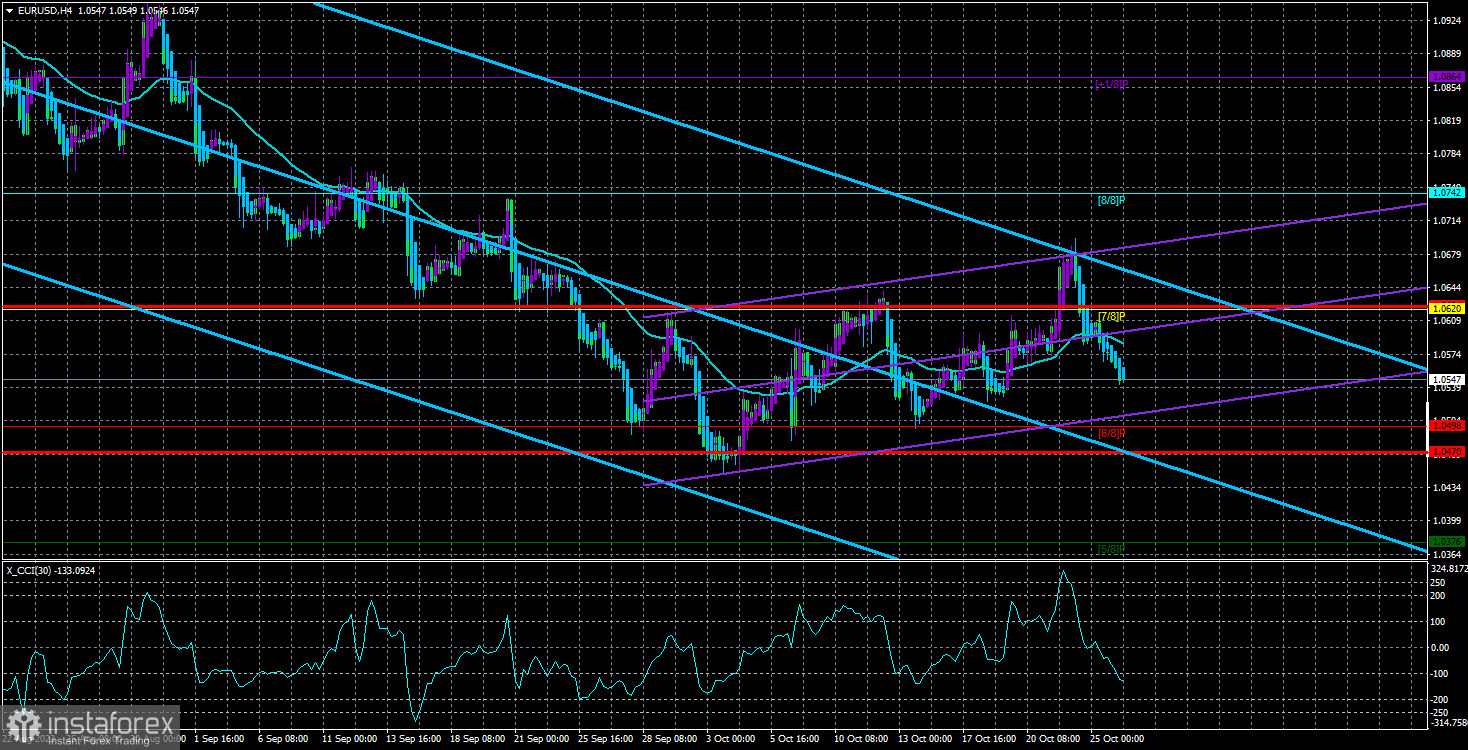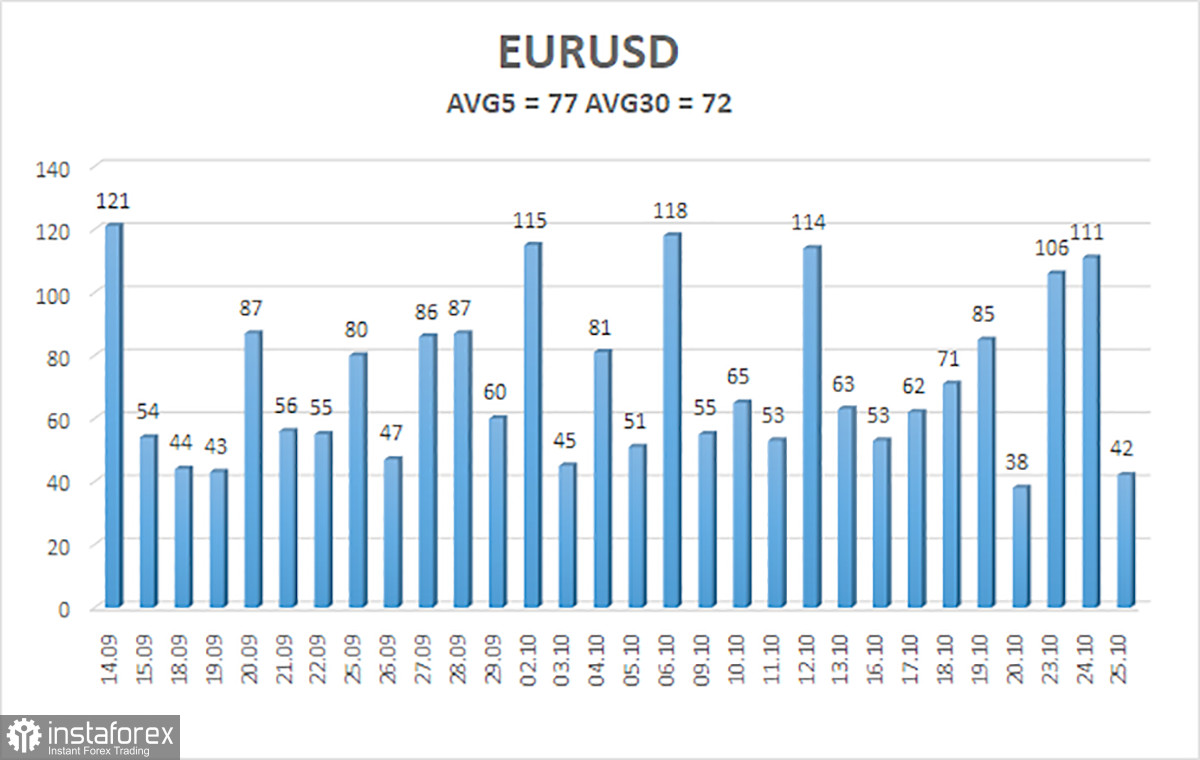
The EUR/USD currency pair continued its downward movement easily and calmly throughout Wednesday. The euro's decline persisted even during the night, when significant price changes are not typically expected. In the illustration above, two segments of an upward correction are clearly visible, indicating that the pair has formed a classical corrective structure consisting of three waves, which could be completed. If this is the case, then we are currently witnessing a resumption of the downward trend. It is worth noting that the euro has all the reasons to continue this movement. It has corrected; that's one reason. It doesn't have any strong drivers for upward movement; that's another reason. Local macroeconomic statistics often favor the dollar; that's reason number three. Therefore, from our perspective, the technical picture for the euro is nearly perfect.
Yesterday, Christine Lagarde gave her second speech this week. However, just like the first time, the ECB President made no noteworthy or interesting announcements. We mentioned earlier that it would be naive to expect any major statements from Mrs. Lagarde a day before the ECB meeting. Moreover, we should not expect anything resonant from the meeting itself. Thus, the decline in quotes yesterday and the day before is clearly not related to the speeches of Lagarde and her colleagues. We could even say that the current movement is purely technical, as it looks so beautifully.
In the 24-hour time frame, the pair temporarily surpassed the 38.2% Fibonacci level at 1.0609 and the critical line. It did not stay above these two levels for even a full day. Therefore, in the daily time frame, there are technical signals for the resumption of the downtrend. There is also the possibility of a consolidation or flat for the pair, but for now, everything looks as if the market is gearing up for a new round of sales.
The ECB is unlikely to support the euro. In principle, there is no intrigue regarding the ECB meeting. The key rate will remain unchanged; no other options are considered. There is only the speech by Christine Lagarde and the accompanying statement. Of course, important or at least interesting information could come out today, but over the past three months, the ECB has actively conveyed to market participants the idea that there will be no new tightening of monetary policy. For the euro to rise, it needs hawkish decisions and statements. We don't expect any such things today.
However, as is often the case, the market's reaction to the meeting's results can be unpredictable, illogical, and emotional. The pair might not even react to the outcome at all. So, almost any movement or reaction is possible. It's essential to remember that the ECB meeting is a significant event regardless. For example, the euro is currently declining, and this movement may be a response to today's results. In this case, even with a dovish rhetoric, we could see the euro's rise. All we want to say is that predicting movements during today's session is impossible. You can only guess them.
But we do not like to guess and speculate. We rely on all available types of analysis to forecast the overall picture and the pair's movement over an extended period. And so far, the conclusion is clear: the euro will continue to decline. If not today or this week, then over the next month, two months, and so on. To start a bull market, the euro needs statements from the Fed about their readiness to begin easing monetary policy. But with inflation in the United States on the rise again, it will be challenging to get such statements in the near term. The Fed is more likely to tighten its hawkish stance further if inflation doesn't begin to slow, and they might raise the key rate again in December. Such a development will continue to support the US dollar, not the euro.

The average volatility of the EUR/USD currency pair over the last 5 trading days, as of October 26, is 77 points, characterized as "average." Therefore, on Thursday, we expect the pair to move between the levels of 1.0470 and 1.0624. A reversal of the Heiken Ashi indicator upwards may indicate a possible new phase of the corrective movement.
Nearby support levels:
S1 – 1.0498
S2 – 1.0376
S3 – 1.0254
Nearest resistance levels:
R1 – 1.0620
R2 – 1.0742
R3 – 1.0864
Trading recommendations:
The EUR/USD pair has resumed its southward movement and consolidated below the moving average. Therefore, you can maintain short positions with targets at 1.0498 and 1.0470 until the Heiken Ashi indicator reverses upward. Long positions can be considered only after the price solidifies back above the moving average, with a target at 1.0742.
Explanations for the illustrations:
Linear regression channels - help determine the current trend. If both channels point in the same direction, it indicates a strong current trend.
The moving average line (settings 20.0, smoothed) - determines the short-term trend and direction for trading.
Murrey levels - target levels for movements and corrections.
Volatility levels (red lines) - the likely price channel within which the pair will trade over the next day based on current volatility indicators.
CCI indicator - its entry into the oversold region (below -250) or overbought region (above +250) indicates an approaching trend reversal in the opposite direction.





















